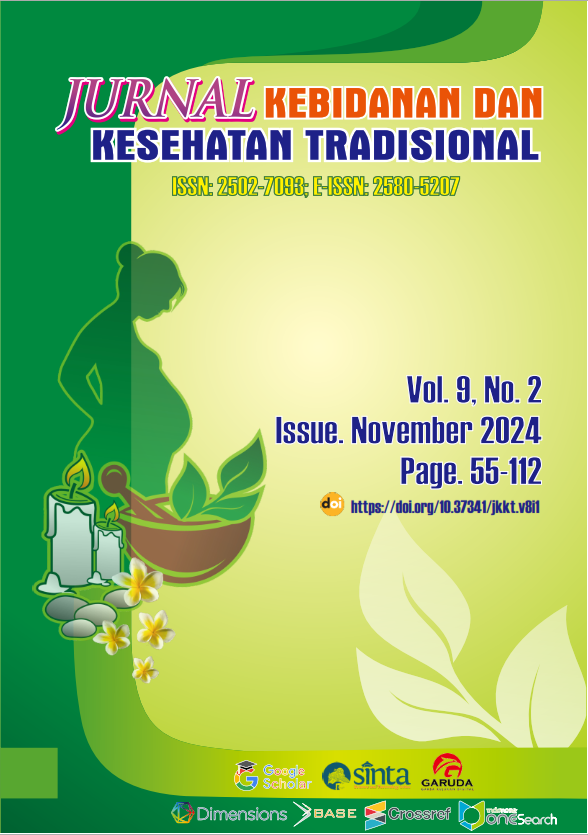Back Pain Intensity in Third Trimester Pregnant Women Participating in Prenatal Yoga
Main Article Content
Abstract
Background: Back pain is one of the most common complaints experienced by pregnant women in the third trimester due to changes in posture, weight gain, and the effects of estrogen and progesterone hormones, which cause ligament and joint relaxation. This condition can reduce the comfort and quality of life of pregnant women. Prenatal yoga is a gentle relaxation and stretching exercise designed to increase flexibility, improve posture, and reduce muscle tension. This study aims to determine the response to back pain in pregnant women in their third trimester who participate in prenatal yoga in the Wedi Community Health Center working area.
Methods: This study used a descriptive approach with total sampling technique. The study population consisted of all pregnant women in their third trimester who experienced lower back pain in the working area of the Wedi Community Health Center in Klaten Regency in 2022, totaling 42 people, all of whom were included in the sample. The research instrument used a Numeric Rating Scale (NRS) checklist to measure pain levels. Data were analyzed descriptively using frequency distribution and percentages.
Results: Before participating in prenatal yoga, most pregnant women experienced moderate pain on a scale of 5, with 19 respondents (45.2%), while after participating in prenatal yoga, the pain decreased to a scale of 2 in 16 respondents (38.1%).
Conclusion: Prenatal yoga has been proven to help reduce the intensity of back pain in pregnant women in their third trimester safely and effectively. It is recommended that health workers develop prenatal yoga classes in health care facilities as a promotional and preventive measure to improve the comfort and well-being of pregnant women.
Article Details
References
Amalia, A. (2015). Tetap sehat dengan yoga. Panda Media.
Andarmoyo, S. (2017). Konsep dan proses keperawatan nyeri. Ar-Ruzz Media.
Aprillia, Y. (2020). Prenatal gentle yoga. PT Gramedia Pustaka Utama.
Awlya, G. (2020). Efektivitas prenatal yoga terhadap nyeri punggung pada ibu hamil trimester III di PMB Lismarini dan PMB Meli Rosita Kota Palembang. Jurnal Ilmiah Kesehatan. Poltekkes Palembang.
Bimariotejo. (2018). Hubungan antara postur tubuh dan nyeri punggung bawah pada pasien poliklinik neurologi. Jurnal Universitas Sumatera Utara. http://www.journal.usu.ac.id
Dahlan, S. (2020). Besar sampel dalam penelitian kedokteran dan kesehatan (5th ed.). Salemba Medika.
Dahlan, S. (2021). Statistik untuk kedokteran dan kesehatan (6th ed.). Epidemiologi Indonesia.
Davies, W. (2017). Pengaruh teknik akupresur terhadap intensitas nyeri pinggang ibu hamil trimester III di Klinik Isti Medika, Desa Pringsari, Kecamatan Pringapus, Kabupaten Semarang. Skripsi. Politeknik Kesehatan Semarang.
Diferiansyah, O., Septa, T., & Lisiswanti, R. (2016). Gangguan cemas menyeluruh. JUKE Unila, 5(2), 63–68. https://juke.kedokteran.unila.ac.id
Fitriani, L. (2018). Efektivitas senam hamil dan yoga hamil terhadap penurunan nyeri punggung pada ibu hamil trimester III di Puskesmas Pekkabata. Jurnal Kesehatan Masyarakat, 3(2), 87–95.
Furlan, A., Imamura, M., Dryden, T., & Irvin, E. (2015). Massage for low back pain. Cochrane Database of Systematic Reviews. https://doi.org/10.1002/14651858.CD001929.pub3
Gutke, A., Boissonnault, J., Brook, G., & Stuge, B. (2017). The severity and impact of pelvic girdle pain and low back pain in pregnancy: A multinational study. Journal of Women’s Health, 27(4), 1–8.
Hakiki, I. (2015). Efektivitas terapi air hangat terhadap nyeri tulang belakang pada ibu hamil di wilayah kerja Puskesmas Pisangan. Skripsi, UIN Syarif Hidayatullah Jakarta.
Hall, J. E., & Guyton, A. C. (2019). Guyton dan Hall: Buku ajar fisiologi kedokteran (13th ed.). Elsevier.
Kementerian Kesehatan Republik Indonesia. (2020). Profil data kesehatan Indonesia. Direktorat Jenderal Kesehatan Masyarakat.
Kurniati, dkk. (2017). Hubungan efektivitas teknik massage dan teknik relaksasi dengan pengurangan nyeri punggung pada kehamilan trimester III di Klinik Pratama Medika Keluarga Cipinang Muara Jakarta Timur. Jurnal Ilmu Budaya, Universitas Nasional.
Polit, D. F., & Beck, C. T. (2018). Essentials of nursing research: Appraising evidence for nursing practice (9th ed.). Wolters Kluwer.
Putri, & Rahmita. (2019). Terapi komplementer: Konsep dan aplikasi dalam keperawatan. PT Pustaka Baru.
Putra, M. (2019). Pengaruh yoga terhadap kecemasan ibu hamil primigravida trimester III di Puskesmas Rawang Pasar IV Kecamatan Rawang Panca Arga Kabupaten Asahan tahun 2019. Excellent Midwifery Journal, 8(5), 55–60.
Salam, B. (2016). Hubungan paritas dengan kejadian nyeri punggung bawah di Poliklinik Saraf RSUDZA. Skripsi. Universitas Syiah Kuala Darussalam, Aceh.
Sinclair, M., et al. (2014). How do women manage pregnancy-related low back and/or pelvic pain? Descriptive findings from an online survey. Evidence-Based Midwifery, 12(3), 76–82.
Tyastuti, S. (2016). Asuhan kebidanan kehamilan. Kementerian Kesehatan RI.
Ulfah, M., & Wirakhmi, I. N. (2017). Studi korelasi umur kehamilan dengan kejadian nyeri punggung ibu hamil. Prosiding Seminar Nasional STIKes Harapan Bangsa Purwokerto.
Wiarto, G. (2017). Nyeri tulang dan sendi. Gosyen Publishing.
Yuniarti, & Eliana. (2020). Pengaruh senam prenatal yoga terhadap kesiapan ibu primigravida dalam menghadapi persalinan di BPM Kota Bengkulu. Jurnal Media Kesehatan, 13(1), 9–17.

